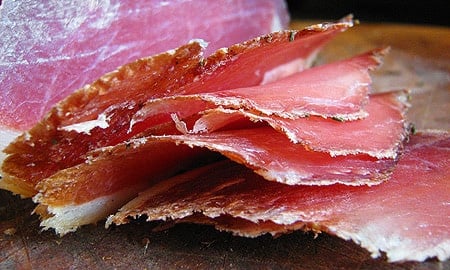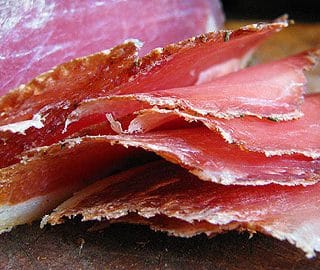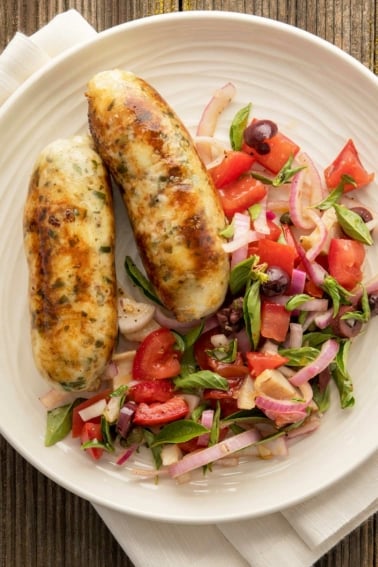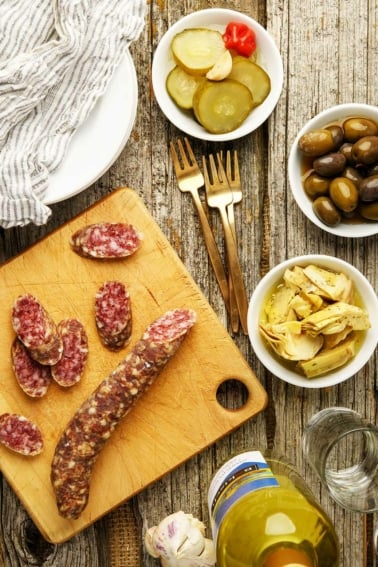As an Amazon Associate I earn from qualifying purchases.

Pork is the lone meat I still buy, in no small part because I have access to heritage pork raised the old way, with a varied diet and generally darker and fattier meat than that crap you get at the supermarket. I do routinely shoot wild hogs, too, and they are excellent for this recipe, Italian lonzino.
Lonzino is a fabulous dry-cured cut of pork that ages into a lovely pink, slices well and tastes not unlike a good cured ham. The Spanish call this same thing lomo. And if you coat the meat with a certain set of spices, it becomes the Armenian favorite basturma.
You use the loin of the pig for this recipe. Trimmed of all sinew, and, depending on your preference, fat. I prefer my lonzino lean, but some people love the fat v. lean you get with each bite. Either way works.
The coolest thing about lonzino is how easy and relatively quickly you can make it. Unlike prosciutto, which takes more than a year, lonzino can be ready in a month.
The only special equipment you need is curing salt and a cool place to hang your loins. You can get curing salt, Instacure No. 2 online, and your hanging place can be anywhere that isn’t bone dry (70 to 80 percent humidity is good) and is anywhere from 40°F to 60°F.
And like I mentioned at the beginning of this, you also need good pork. Lonzino highlights the innate qualities in your pork, so if it is factory-farmed you will very definitely notice – especially if it is put up next to a piece of quality pork. So do youself a favor and buy the good stuff.
Note that the time in the recipe does not include cure time.
A word on salt. You need to weigh your meat in grams and then weigh out 2.5 percent of that weight in sea salt or kosher salt, plus 0.25 percent, that’s one-quarter of one percent, in curing salt No. 2, which contains sodium nitrate. Weigh out an equal amount of sugar to the salt and add that to the mix.
Lonzino, Air Cured Pork Loin
Ingredients
- 1 length of pork loin, about 3 pounds
- kosher salt (see above)
- sugar (see above)
- InstaCure No. 2 (see above)
- 10 grams black pepper
- 5 grams garlic powder
- 5 grams ground cloves
- 10 grams onion powder
- 8 grams dried thyme
Instructions
- Mix all the dry ingredients. Rub them well into the loin, then put the meat into a plastic bag or wrap with plastic wrap. This is to keep it from drying out. Keep the meat refrigerated for a week to 12 days.
- When the meat has firmed up, remove from the wrap, rinse it off and then let it dry on a rack for 2 to 3 hours. I use a portable fan set on low to oscillate over the meat.
- Truss the meat with kitchen twine (the white stuff) as you would a roast. Leave a long loop at one end so you can hang the meat. You can also use pre-made sausage netting.
- Hang the meat in a cool place to dry. It needs to be humid, about 70 percent humidity. How long? At least another 12 days. It should feel firm throughout and be a pleasing red. How long can you hang it? Up to six months or more, but it will become harder and drier the longer it hangs. If you've found you have dried it too much, let it go all the way to hard-as-a-rock stage. Then use a microplane grater to grate the dried meat over pasta or rice.
- To store: Wrap tightly in butcher paper or, better yet, vacuum seal pieces of it – I cut the loin into three chunks – and freeze. Unfrozen, it will last indefinitely in the fridge, but it will continue to dry out.
Notes
Nutrition information is automatically calculated, so should only be used as an approximation.






Thanks Hank
Two more quick questions. I found a place that is cooler, but it is also somewhat dusty, and has a lower humidity (that I could not really control). Would trussing it in some cheese cloth or muslin help solve the humidity problem as it would create somewhat of a microclimate inside the cloth?
Also, is it ok to use instacure #1 instead of #2?
Thanks in advance, and I am really stoked for this
David: It’s not ideal, and in the first couple weeks of curing is especially bad. I never let my charcuterie get above 60 degrees until it is very far along. Once it’s more or less cured, i.e., a few weeks, temperature matters less.
I was wondering how important temperature is? Is it ok if it hits mid 70’s for a couple hours a day as long as it is cool at night?
Paul: I wouldn’t. The smallest piece I’ve ever use has been about 10 inches long. I don’t have a recipe online for it, but if you look up Cajun tasso ham you might be able to do it that way. Sorry!
I have a large bag of pork loin chunks, anywhere from 1-3 inch thick. Can this be
made from pieces or does it have to be whole muscle?
Enjoy your site a lot.
Marilyn: Don’t know what to tell you about the curing setup, but if you want to leave out the sugar, go right ahead. It’s only there for flavor. And, um, there is no corn syrup in any of my recipes.
As for the spices and herbs, those qualify as natural flavorings, so leave them out, too. Bottom line: If you want a very basic lonzino, use only the salt and curing salt. If you fear nitrates, don’t do this recipe if you are a beginner. You have to be a skilled charcutiere to make this without the protection of the Instacure.
Stumbled across this site while looking for ways to cure pork. Living in N’Awlins, there ain’t no such thang as a basement, unless you fancy an indoor swimming pool. (I’m on HIGH ground, FIVE FEET above sea level!) Been trying to figure out where I could put a refrigerator-cure box, but I don’t have a garage (Hurricane Katrina took it), never had a porch, and the house is too small for another fridge.
I make a bunch of things for myself because I cannot, for medical reasons, have any sugar, starch, natural or artificial flavorings, etc. etc. etc.
Every recipe I see for a ham-like recipe uses sugar, scorch it. Which means, assuming I can create a cure box, I could make the above recipe, but could not eat it myself, which is the whole point of do-it-yourself.
Is there a recipe around using honey? And no !@#$#@! corn syrup?
Kevin: Remember to drop the humidity back toward 60% over time as the lonzino ages. Ratchet it down every week or two by a little. I don’t case my lonzino. I’ve never tried the olive oil rub, but smearing lard on it will work pretty well.
Love the blog.
Just got done building a little cold room in a corner of my basement for my lonzino. Keeping a steady 52F. Had to add a humidifier to get it up to 85%. Outa of the cure today and ready to hang. I forgot to order casings. I want to try the olive oil rub down ,or do you think larding would be better?
Thanks
Ted, how is yours coming along?
Ted: I’d let the white mold grow — if it is dry mold. If it is fuzzy like a cotton ball, wipe it off with vinegar. And I eat it when the lonzino is ready. BUT, if you are allergic to penicillin, wipe off all white mold. In many cases the white mold IS penicillin…
Hi Hank, I’m dry curing Lonzino, I’m at day 20 of 30, I read above that white mold is good to see on the meat, I’m starting to see some on mine, I didn’t use a casing, I followed the advice of someone who said that they brushed olive oil at day 1 of dry-curing. My question is 1. Should I let the white mold build up until day 30 or should I rub it off with a vinegar/water mix? 2. At the end of the dry-curing time, should the white mold be taken off before eating?
Thanks
Great blog, thanks for the info! I have one now in the fridge with the cure on it going on a week now. I’m planning on curing it in a cooler in my basement. That way I can control the humidity because it is bone dry down there naturally.
Humidity is VERY important. My suggestion would be to run a humidifer next to the hanging meat when the ambient humidity gets that low. You want it to dry slowly and evenly; low humidity hardens the outside before the inside can dry properly, and it rots. Ew.
How important is the humidity for making lonzino? Here in MN, my basement gets nice and cool in the winter (& summer for that matter), but the humidity drops to around 40 to 50%. Any ideas????
I mean the backstraps, which are the “loin,” to a butcher. The “tenderloin” is underneath the spine and is so yummy outsiders rarely get any of the ones I collect…
Florida wild boar lonzino would be an excellent use for some of that backstrap! Trim it well to make a rough cylinder, and cut a piece – ideally – about 12-14 inches long.
The spear, huh? Wow.
When you say pork “loin” do you mean the tender loins or the backstraps? It just so happens I am in possession of some Flordia wild piggy that fell to the spear back in January. I think this would be a noble application.
I’m still happily experimenting with Ruhlman and Polcyn, but have some trouble finding decent meat. I do plan on checking out a butcher I just found about 50 miles north of me.
Mmm…air-cured wild boar. This sounds lovely and intense. And makes my experiments with bacon (and currently pancetta) seem tame…
You had me at ‘cured pork’.
My interest in cured items is at an all-time high. We’re moving in April and plans are underway for the construction of both a wine cellar, and a cellar appropriate for dry-curing meats. I cannot wait. I will likely be digging through your posts later this year to give this a shot.
Hank,
Great to see write up’s like these. I’ve managed to get hold of a copy of Ruhlman & Polcyn’s ‘Charcuterie’ over here and it’s a great read. If our two countries are supposed to be great allies how come we can’t get more of your books?!
Happy curing.